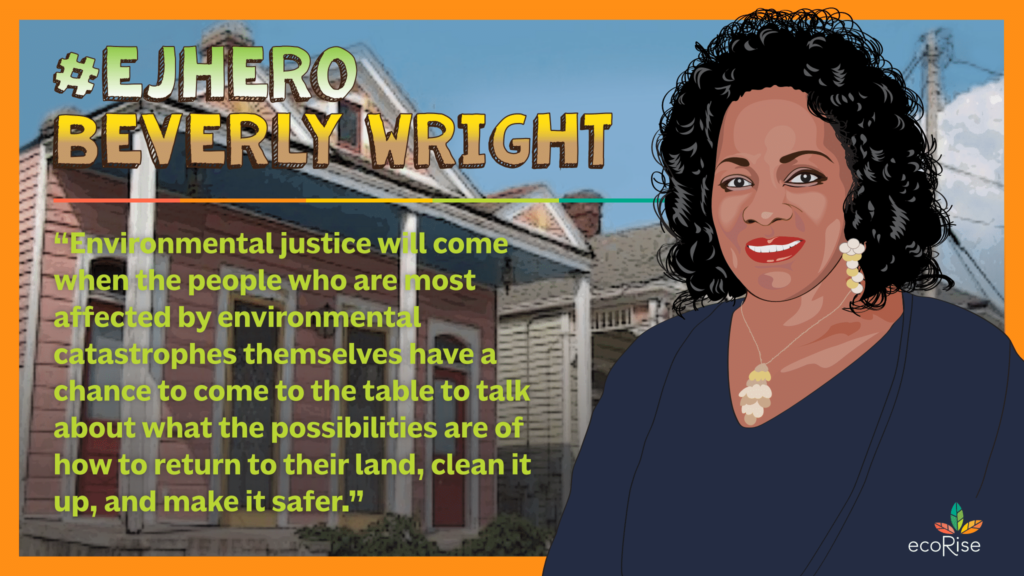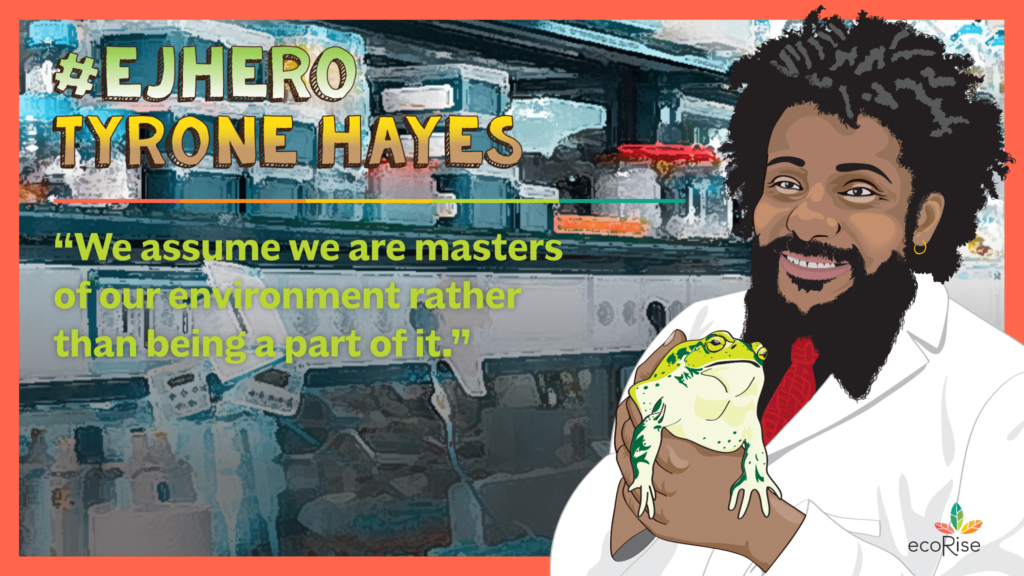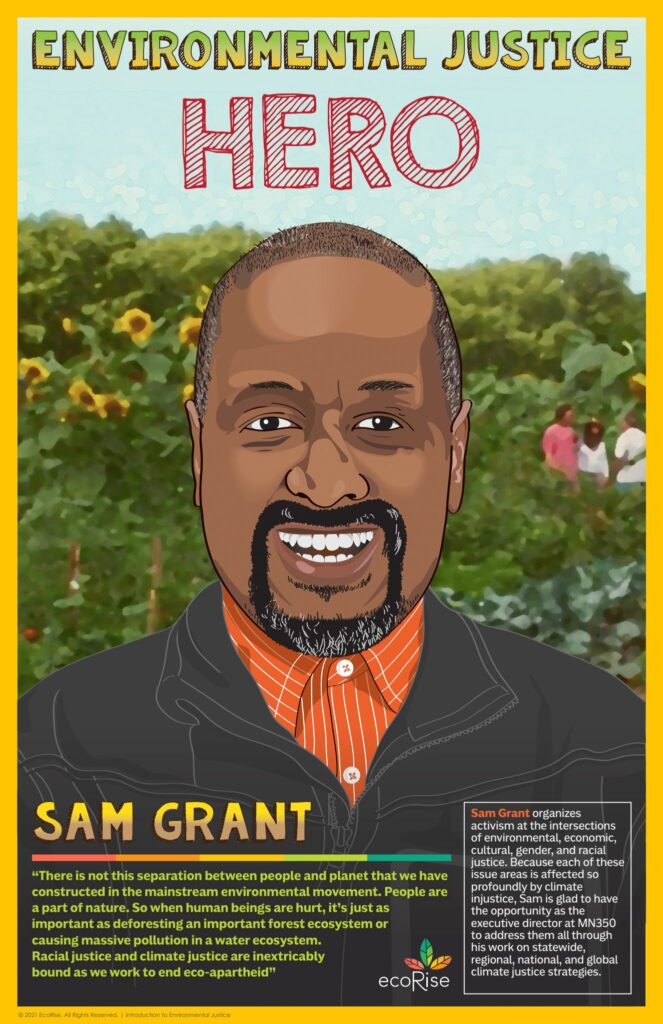Written by Cassandre Arkema
Did you know the first mayor of any American city to implement equity planning was a Black leader named Carl B. Stokes?
Did you know the first scientist to use biomimicry to look at nature was a Black inventor named George Washington Carver?
Did you know the first piece of federal legislation to create “green jobs” was advocated for by a Black leader named Van Jones?
Black leaders built the foundation for the environmental justice movement through commitment, research, and advocacy. This has been necessary because racism is interwoven into the economic, social, and political systems around us. As a result, Black communities experience disproportionate economic, social, and environmental harms that they are not responsible for. Environmental justice led by Black leaders works against patterns of systemic racism and injustice to build a sustainable future for all. Celebrate these changemakers by learning more about the movement and their work below!
What is environmental justice?
Environmental justice is the access to a clean and safe environment for all people, regardless of race, class, gender, or ability.
The environmental justice movement can be traced back to Indigenous people who resisted U.S. settler-colonialism and the exploitation of Native land. Their work continued throughout history by people from every race and class because Black, Indigenous, and People of Color (BIPOC) communities’ access, health, and opportunities were ignored by mainstream environmentalism.
The term environmental justice was publicly defined for the first time by Delegates at the First National People of Color Environmental Leadership Summit held on October 24-27, 1991, in Washington, DC. Delegates from BIPOC communities convened with members of federal, state, and local governments to adopt the 17 principles of Environmental Justice. Watch this short documentary to experience firsthand the words of the delegates at the First National People of Color Environmental Leadership Summit, who helped shape the environmental justice movement today.
Bring the exploration of environmental justice history, topics, and systemic solutions into your classroom with EcoRise’s Introduction to Environmental Justice curriculum.
What is an #EJHero?
An environmental justice hero dedicates their life’s work so that all people can experience access to a clean and safe environment regardless of their race, class, gender, or ability. Environmental justice heroes demand the political, economic, and cultural freedom of BIPOC communities and understand the history of exploitation, colonization, and oppression these communities have faced. We celebrate environmental justice heroes because their work is eliminating environmental racism, building environmental justice, and creating the foundation for a sustainable world for all. You can find stories about these inspiring individuals by searching “#EJHero” on Twitter or Facebook.
Foundational #EJHero-es
Learn from the environmental justice heroes highlighted in EcoRise’s Introduction to Environmental Justice curriculum who innovated solutions to create change and address environmental hazards in their communities. Their commitment built the foundation for future heroes to advocate for environmental justice.
Dr. Beverly Wright is an advocate, a professor, and the founder of the Deep South Center for Environmental Justice. She conducted pivotal research on pollution in Louisiana, which helped launch the environmental justice movement. She went on to develop job training and curricula to support learners of all ages in the field of sustainability. Learn from Beverly about the relationship between pollution and communities of color and how climate change is compounding health issues for these communities across the United States.
LaDonna Redmond is an activist and leader dedicated to public health issues such as substance abuse, violence, and food justice. She is known for building sustainable food systems that help schools fight and heal from injustice. Thanks to LaDonna, Chicago Public Schools eliminated unhealthy food from their cafeteria menus. She works to expand access to healthy food, laying the groundwork for environmental justice in communities. Hear LaDonna share why school lunch matters.
Dr. Robert Bullard is a distinguished professor of urban planning and environmental policy at Texas Southern University. He is known as the Father of Environmental Justice because in 1990, he was the first to find evidence that 100% of city-operated landfills were located in and causing environmental harms to communities of color. Hear Robert discuss how his research proved insights to patterns of environmental racism across the nation and around the world.
Sam Grant works at the intersection of economic, cultural, and environmental justice as the Executive Director of MN350. He spent more than 30 years educating, consulting, and organizing communities to focus on justice at Metropolitan State University and other higher education institutions. Sam is also the founding former president of the Sierra Leone Foundation for New Democracy. Hear Sam explain how deep democracy recognizes every story to build climate justice.
Savi Horne has dedicated her life’s work to promoting BIPOC wealth, land preservation, and rural livelihoods. She is the Executive Director of the non-profit law firm North Carolina Association of Black Lawyers’ Land Loss Prevention Project. She created the Land Loss Prevention Project to provide legal expertise, community education, and advocacy skills to farmers and rural landowners facing legal, economic, and environmental challenges. Learn from Savi how local farmers ground their community in social justice, environmental justice, and political action.
Dr. Tyrone Hayes is a scientist, a professor of integrative biology at UC Berkeley, and a 2020 Rodale Institute Organic Pioneer. His research found that the widely used herbicide atrazine negatively harms human health after discovering that the chemical was affecting reproductive hormones in frogs, leading to the decline of their population. His research has led to regulations that will help protect drinking water and the health and safety of many. Learn how Tyrone used research to stand against one giant corporation.
Share the words and wisdom of these heroes with our #EJHero quote graphics.
More Black #EJHero-es to Celebrate
The work of #EJHero-es still continues today. Throughout Black History Month, EcoRise shared stories of these inspiring individuals on social media and they are now compiled here for students and teachers to continue learning from. Celebrate Black History and uplift Black voices any time of the year by learning from some of the Black #EJHero-es who are committed to furthering the environmental justice movement today.
Dr. Ayana Elizabeth Johnson always asks “what about the ocean?” in her work as a marine biologist, policy expert, and writer. She founded the Urban Ocean Lab, a think tank for the sustainable future of coastal cities, co-created the podcast How to Save a Planet, and is a best-selling author. Learn about the importance of protecting the ocean and how you can join the movement from Ayana.
Ineza Umuhoza Grace is an eco-feminist and organizer dedicated to inspiring youth to protect the environment. She fosters climate justice and connects people to advocacy resources and community through two non-profits, the one she founded. Green Protector, and the other she co-founded, Loss and Damage Youth Coalition. Learn about climate migration from this young climate leader.
Dr. John Francis is an environmentalist who started the planetwalker movement. After he witnessed an 840,000 gallon oil spill in San Francisco Bay he decided to protest fossil fueled transportation and take a 17 year vow of silence. During that time, he completed three college degrees, a PhD in land management, and launched his non-profit PlanetWalk, which fosters a global network of planetwalkers today. Learn about environmental respect and responsibility from John’s 22 year protest.
Barbados Prime Minister Mia Amor Mottley is the recipient of the 2021 Champions of the Earth Award, the United Nations’ highest environmental honor, for her policy leadership against those driving climate change. She is an advocate for countries that emit the least carbon, but experience the greatest effects of climate change. Learn about Mia’s work to mitigate the extreme effects of climate change in Barbados by rebuilding everything from roofs to reefs.
Dr. Mustafa Santiago Ali has been committed to environmental justice in his work as a thought-leader, policymaker, and activist throughout his career. He elevated environmental justice issues and worked across federal agencies to strengthen environmental justice policies, programs and initiatives at the EPA for 24 years. He is now the Senior Vice President of Climate, Environmental Justice & Community Revitalization at Hip Hop Caucus. Learn about the effects of pollution on health and livelihoods from Mustafa.
Udokam Iroegbu is a Black Lives Matter, also known as BLM, activist working towards just transportation design at the City of Vancouver. Her work is centered around engaging the public on transportation projects. Udokam advocates for the rights and lives of Black people, while standing in solidarity with the Indigneous people of Coast Salish Territory. Learn how every thread of environmental justice is linked to racial justice as Udokam asks “how is anything not racial justice?”
You can bring #EJHero inspiration to your classroom with the EcoRise #EJHero poster series which is free to download and print. This poster series is a part of EcoRise’s Introduction to Environmental Justice curriculum, which was developed in partnership with Groundwork USA. These lessons are available for free to educators. Learn more about the curriculum here.
Why do we need Black #EJHero-es?
While an #EJHero can be of any race, nationality, and background, it is important to support the work of Black #EJHero-es in the U.S. because there is a history of injustice in politics, the economy, and the environment that has left BIPOC communities systemically neglected. The environmental hazards BIPOC communities experience are only exacerbated by systemic racism and discrimination, making it clear that environmental justice is inextricably linked to racial and social justice. Prioritizing Black voices in environmental work helps not only Black communities, but all communities, heal from environmental degradation and ensure that everyone is able to have the same quality of life.
The statistics below were found through research by national organizations and Black leaders like Dr. Robert Bullard who study patterns of environmental racism to find data that proves trends of discrimination in the distribution of environmental benefits and hazards across the United States.
African- American communities were overrepresented in communities with waste sites, even though African-American communities only made up ⅕ of the population in that EPA Region.
US GAO 1983
3 out of 5 African-American and Latinx communities had municipal toxic waste sites in their neighborhoods.
UCC 1987
BIPOC communities are approximately 3x more likely to be located near a commercial hazardous waste facility than predominantly white communities, nationally.
Bullard et al. 2007
BIPOC communities are more likely to have dilapidated infrastructure and be built on historically toxic, polluted, or contaminated land.
NCRC 2018
Environmental hazards decrease property values, which contributes to under-resourced schools and compromised education.
NCRC 2018
BIPOC families are more likely to live in historically redlined areas, which, today, are more segregated and have fewer resources available for their community members.
NCRC 2018
It’s likely that you and your students have diverse connections to racial identity, industry, and the environment, and talking about these subjects is not always easy. Due to sociopolitical marginalization, BIPOC youth can easily be caught in a cycle of pollution, poor health, educational inequities, negative interactions with the criminal justice system, and economic blight, all of which compromises their access to opportunities and the capacity of their families to thrive.
Connected to the right resources, youth have unlimited potential to address cycles of harm in their communities. In order to break these cycles, it is essential to develop community-based solutions and prioritize the voices of Black leaders in sustainability to inspire youth to become #EJHero-es too!
Sources
Dr. Mustafa Santiago Ali, “The Fight For Environmental Justice & Climate Justice in the 21st Century,” Seminar at American University The Sine Institute of Policy and Politics, Washington, DC, Feb 3, 2022.
Bruce Mitchell PhD. and Juan Franco, HOLC “Redlining” Maps: The Persistent Structure Of Segregation And Economic Inequality, NCRC, March 20, 2018, https://ncrc.org/holc/.
“Environmental Justice/Environmental Racism,” Energy Justice Network, 2022, http://www.ejnet.org/ej/.
Dr. Sacoby M. Wilson, Environmental Justice Movement: A Review of History, Research, and Public Health Issues, University of Maryland, Spring 2010.
United Church of Christ (UCC) Commission for Racial Justice, Toxic wastes and race in the United States: a national report on the racial and socioeconomic characteristics of communities with hazardous waste sites , UCC, 1987, https://www.nrc.gov/docs/ML1310/ML13109A339.pdf.
United States General Accounting Office (USGAO), Citing of hazardous waste landfills and their correlation with racial and economic status of surrounding communities , USGAO, 1983, https://www.gao.gov/products/rced-83-168.
Wing, Steve, Dana Cole, and Gary Grant, Environmental injustice in North Carolina’s hog industry, Environmental Health Perspectives, 108: 225-231, 2000, https://www.ncbi.nlm.nih.gov/pmc/articles/PMC1637958/.
















